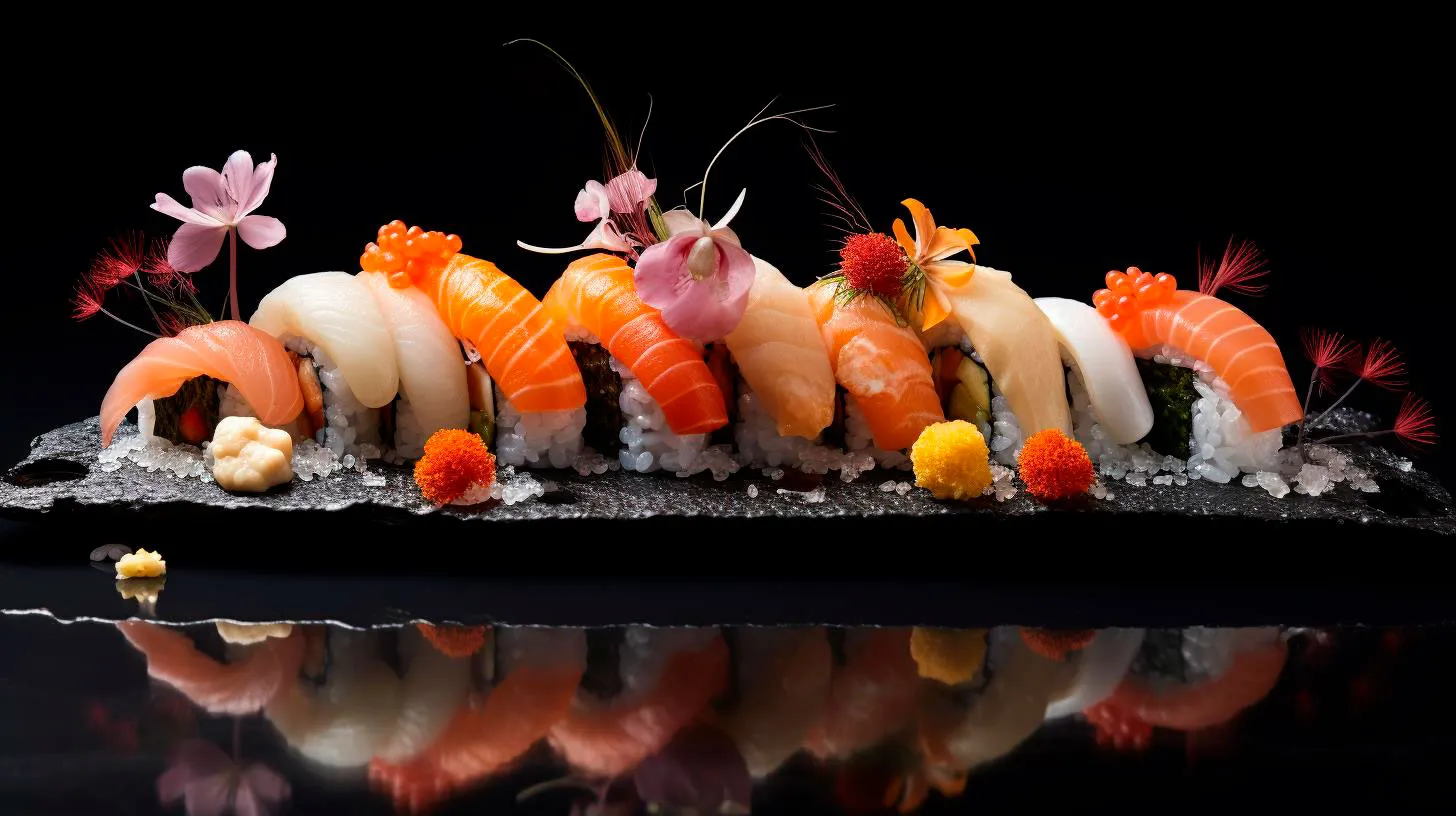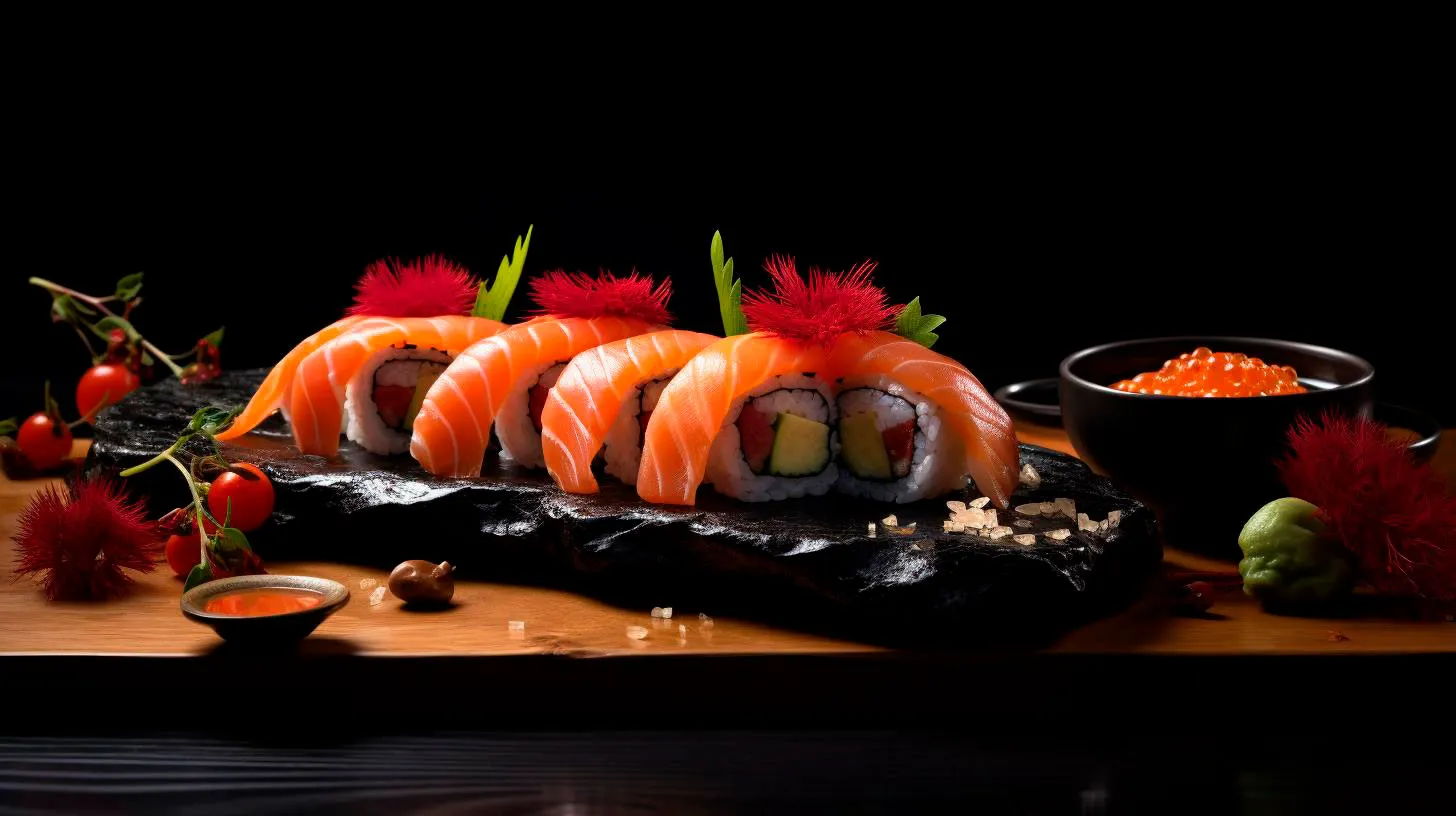Examining the Cultural Significance of Sushi in Japan
In this blog post, we will delve into the cultural significance of sushi in Japan, exploring its history, various types, and the impact it has had on global gastronomy.
The Evolution of Sushi
Sushi, as it is known today, traces its roots back to ancient Japan. Originally born out of the need to preserve fish, the practice of fermenting raw fish with rice dates back to the 2nd century AD. However, it was during the Edo period (1603-1868) that sushi began to take the form we are familiar with today.
The credit for shaping modern sushi goes to Hanaya Yohei, a sushi chef from Tokyo. He revolutionized the concept by serving bite-sized pieces of raw fish on top of vinegared rice. This innovation made sushi more accessible and convenient for eating, solidifying its place as a popular fast food option in Japan.
Over time, sushi evolved further to include new ingredients, such as soy sauce, wasabi, and pickled ginger, to enhance flavor and balance. The emergence of nigiri sushi, maki rolls, and other sushi styles broadened the options available to sushi enthusiasts, establishing a diverse culinary landscape.
The Japanese Art of Sushi
One aspect that sets sushi apart is its presentation. Sushi chefs view the preparation of sushi as an art form and pay meticulous attention to detail. Each piece is crafted with precision, reflecting the harmony of colors and textures. It is not uncommon for sushi chefs to undergo many years of training to master the art of sushi making.
The artistry involved in sushi is not limited to its appearance; it also extends to the taste. The balance between the fish, rice, and seasoning, combined with the unique flavors of each ingredient, creates a delightful gastronomic experience that tantalizes the taste buds.
Key Takeaways
- Japanese sushi traces its roots back to ancient times, with its modern form emerging during the Edo period.
- Sushi is an art form, with chefs dedicating years to perfecting their craftsmanship.
- The diverse types of sushi, such as nigiri and maki rolls, offer a wide range of flavors and options.
- The delicate balance of flavors and textures in sushi is a testament to the meticulousness of its preparation.
Sushi’s Global Impact
In recent years, sushi has transcended borders and become immensely popular worldwide. Its simplicity, elegance, and health benefits have contributed to its global appeal.
Sushi’s popularity has given rise to sushi bars and restaurants all over the world, creating a multi-billion dollar industry. According to the Japan External Trade Organization, the global market for Japanese food, including sushi, reached a staggering $34 billion in 2019, with the United States being its largest consumer market.
The global demand for sushi has had positive socio-economic impacts in Japan. It has boosted international tourism and encouraged culinary exchange, as tourists flock to sushi restaurants in search of an authentic dining experience.
Advantages of Sushi
- Sushi is a healthy food choice, rich in omega-3 fatty acids and essential nutrients.
- It offers a wide variety of options, catering to different dietary preferences and restrictions.
- Sushi’s elegant presentation and unique flavors make it a sophisticated dining experience.
- The global popularity of sushi has contributed to the growth of the Japanese food industry and tourism sector.
Preserving Tradition, Embracing Innovation
While sushi has undoubtedly become a global sensation, the cultural significance and traditions behind its preparation remain deeply ingrained in Japan.
Traditional sushi establishments, known as “sushi-ya,” continue to uphold the ancient principles of sushi making. These revered institutions maintain a strict focus on quality and authenticity, using the freshest ingredients sourced from local waters.
At the same time, innovation within the sushi industry has allowed for creative interpretations and exciting flavor combinations. Sushi fusion, incorporating elements from other cuisines, has gained popularity, giving birth to unique rolls that cater to diverse tastes and preferences.
Bringing People Together
Sushi has become more than just a dish; it has become a way to connect people from different cultures and backgrounds. Sushi bars and restaurants have become meeting grounds where individuals can come together and share in the joy of exceptional food.
The cultural significance of sushi extends far beyond its Japanese origins. It has become a universal symbol of culinary excellence, encouraging people to explore new flavors and appreciate the intricacies of Japanese cuisine.
Key Advantages of Sushi’s Global Popularity
- Sushi encourages cultural exchange and promotes understanding between different countries.
- It creates employment opportunities in the restaurant and hospitality industry worldwide.
- The popularity of sushi generates revenue for local fisheries, contributing to the sustainability of marine ecosystems.
- Sushi’s global influence has led to the creation of innovative sushi variations that cater to diverse tastes.
In conclusion, sushi’s cultural significance in Japan cannot be overstated. From its humble origins to its worldwide popularity, sushi continues to represent the artistry and elegance of Japanese cuisine. As we enjoy each carefully crafted bite of sushi, we not only savor its delectable flavors but also pay homage to a centuries-old tradition that has become a global phenomenon.
The Tradition of Sushi in Japanese Hospitality
So, let’s dive into the wonderful world of sushi and explore the traditions behind this iconic dish.
The Origins of Sushi
The origins of sushi can be traced back to Southeast Asia, where people preserved fish by fermenting it with rice. This preservation technique allowed the fish to be stored and transported without spoiling. As trade routes expanded, sushi made its way to Japan. In the early days, sushi was consumed primarily as a street food item before evolving into a delicacy served at high-end restaurants.
Key Takeaway: Sushi originated as a preservation technique for fish and has transformed into a revered Japanese delicacy.
The Craftsmanship of Sushi
Sushi is not just another dish; it’s an art form. The delicate balance of flavors, textures, and presentation is meticulously executed by skilled sushi chefs. These chefs, known as itamae, undergo years of training to perfect their craft. Each piece of sushi is carefully shaped by hand, ensuring that the rice is neither too loose nor too compact, and the fish is sliced to the ideal thickness.
Sushi artisans pay great attention to detail, using only the freshest and highest-quality ingredients. From selecting the right fish to creating the perfect blend of rice and vinegar, every step is crucial in achieving the true essence of sushi.
Key Takeaway: Sushi chefs undergo extensive training to master the art of creating perfectly balanced and visually appealing sushi.
Sushi and Japanese Hospitality
Sushi plays an integral role in Japanese hospitality and culture. The concept of omotenashi, meaning wholehearted hospitality, is deeply ingrained in Japanese society. When you visit a sushi bar or restaurant in Japan, you experience more than just a meal; you become part of a cultural tradition and a carefully crafted dining experience.
Traditional sushi restaurants in Japan often have a small seating area with a counter, providing an intimate setting for diners to interact with the sushi chef. The chef guides the diners through the meal, explaining each piece of sushi and offering recommendations based on their preferences.
Furthermore, sushi is served in small portions, allowing diners to indulge in a variety of flavors without feeling overwhelmed. This promotes a sense of balance and harmony in the overall dining experience.
Key Takeaway: Sushi embodies the Japanese concept of omotenashi, offering diners a unique blend of culinary excellence and warm hospitality.
The Health Benefits of Sushi
Aside from its cultural significance, sushi also offers numerous health benefits. The usage of raw fish provides an excellent source of omega-3 fatty acids, which are known for their heart-healthy properties. Additionally, sushi is often accompanied by pickled ginger, wasabi, and soy sauce, each offering unique health benefits, including improved digestion and boosted metabolism.
Moreover, sushi is generally low in calories, making it a popular choice among health-conscious individuals. With options such as sashimi (thin slices of raw fish) and vegetarian rolls, sushi caters to a wide range of dietary preferences.
Key Takeaway: Sushi offers a nutritious dining option, packed with omega-3 fatty acids and other health-promoting ingredients.
The Future of Sushi
As sushi continues to gain popularity worldwide, it has also evolved to cater to different tastes and preferences. Vegetarian and vegan sushi options have become increasingly prevalent, expanding the choices for those with dietary restrictions. Sushi fusion, combining traditional Japanese sushi with influences from other cuisines, has also emerged as a global culinary trend.
With the advent of modern technology, sushi robots have been developed to assist chefs in speeding up the sushi-making process. However, these technologies are often viewed as complementary to the artisanal craftsmanship of sushi, rather than a complete replacement.
Key Takeaway: Sushi is adapting to changing dietary preferences and technology while preserving its traditional roots.
In conclusion, sushi is more than just a meal – it’s a cultural experience that reflects the traditions of Japanese hospitality. From its humble origins to its status as a world-renowned delicacy, sushi continues to captivate both food enthusiasts and those seeking a taste of Japanese culture. So the next time you savor a piece of sushi, remember the centuries of tradition that have shaped this iconic dish.
Sushi as an Expression of Japanese Artistry and Hospitality
Combining the intricate craftsmanship of sushi chefs with the principles of hospitality, sushi truly becomes an expression of Japanese artistry and hospitality.
The Art of Sushi Preparation
The preparation of sushi is an art form that demands precision, skill, and creativity. Highly trained sushi chefs, known as Itamae, spend years perfecting their craft to deliver the ultimate sushi experience. From selecting the finest and freshest ingredients to shaping the sushi by hand, every step is executed with meticulous attention to detail.
Here are some key features and advantages of sushi preparation:
- Knife Skills: Sushi chefs are known for their exceptional knife skills. They use specialized, razor-sharp knives to precisely cut and slice the fish, ensuring the perfect balance of flavors and textures.
- Sourcing Fresh Ingredients: Sushi is all about the freshness of its ingredients. Chefs take great care in selecting the highest quality seafood, often procured directly from local fish markets.
- Presentation: Sushi is not only a feast for the taste buds but also for the eyes. Chefs create visually stunning and elegant presentations, arranging the sushi pieces artfully on the plate.
Sushi as a Symbol of Hospitality
In Japanese culture, hospitality, or Omotenashi, plays a significant role. Sushi embodies this spirit of hospitality, as it aims to please not only the palate but also the soul. From the moment you step into a traditional sushi restaurant, you are greeted with warm hospitality and attention to detail.
Let’s explore the key takeaways and advantages of sushi as a symbol of hospitality:
- Customization: Sushi chefs respect the preferences and dietary restrictions of their guests. They strive to create a personalized experience, catering to individual tastes and ensuring everyone can enjoy their meal.
- Interactive Dining: Sushi bars and counters offer an interactive dining experience where guests can observe the chef’s expert techniques up close. This engagement fosters a welcoming atmosphere and promotes conversation between the chef and the guests.
- Attention to Detail: From the presentation of the sushi to the ambiance of the restaurant, every aspect is carefully considered to provide a memorable dining experience. This meticulous attention to detail is synonymous with Japanese hospitality.
The Importance of Sushi in Japanese Culture
Sushi’s significance in Japanese culture goes beyond being a delectable meal. It has become a symbol of national pride, representing the country’s dedication to excellence and tradition. In fact, sushi has been recognized as an Intangible Cultural Heritage by UNESCO, further highlighting its cultural importance.
Key takeaways on the cultural importance of sushi:
- Celebrating Seasons: Traditional sushi omakase menus often change with the seasons, highlighting seasonal ingredients and flavors. This practice pays homage to Japan’s deep appreciation for nature and the changing seasons.
- Centuries of Tradition: Sushi techniques and traditions have been passed down through generations, forming an integral part of Japanese culinary heritage. This preservation of tradition is deeply ingrained in Japanese culture.
- Global Influence: Sushi’s popularity worldwide not only showcases the culinary excellence of Japan but also promotes cultural exchange. Sushi has become a bridge between different cultures, allowing people to appreciate and experience Japanese traditions.
In conclusion, sushi is far more than just a dish – it is a reflection of Japanese artistry and hospitality. By combining meticulous preparation techniques with a deep focus on hospitality, sushi creates a unique sensory experience. Whether you savor it as a culinary masterpiece or as a representation of Japanese culture, sushi truly exemplifies the harmony of flavors and the beauty of Japan’s rich traditions.
Unraveling the Science behind Sushi in Japanese Hospitality
Let’s delve into the science behind sushi and uncover its secrets.
The Artistry of Sushi Making
Sushi making is not just about assembling ingredients; it is an art form that requires precision, expertise, and an understanding of the science behind the process. Here are some key elements that contribute to the artistry of sushi:
- Ingredients: Sushi is primarily made with raw seafood, including fish like tuna, salmon, and mackerel. The quality and freshness of these ingredients play a vital role in the final taste and texture of the sushi.
- Rice: The type of rice used in sushi, known as sushi rice, is a short-grain rice variety that becomes sticky when cooked. The stickiness allows the rice to hold its shape when tightly packed, making it ideal for sushi rolls.
- Knife Skills: Sushi chefs undergo rigorous training to master their knife skills. The precise cutting and slicing techniques used by these experts ensure that the fish is delicately sliced and presented at its best.
- Presentation: Sushi is not only a treat for the taste buds but also a feast for the eyes. The artful presentation of sushi, known as “mizushōbai,” involves arranging the pieces in a visually appealing manner, often accompanied by decorative garnishes.
The Science behind Perfectly Seasoned Rice
One of the key components of sushi is the vinegared rice. The right balance of flavors in sushi rice is crucial to elevate the overall taste of the dish. Here’s where the science comes into play:
- Proper Rice Washing: Before cooking, sushi rice needs to be thoroughly washed to remove excess starch. This step ensures that the cooked rice doesn’t turn into a sticky mess.
- Acidity Balance: Vinegar is a crucial ingredient in sushi rice, imparting a tangy flavor. Achieving the perfect balance of acidity can be challenging, as adding too much vinegar can overpower the delicate flavors of the fish.
- Gentle Folding Technique: After adding vinegar to the cooked rice, it is gently folded to evenly distribute the flavors. This technique prevents the rice from becoming mushy and maintains its fluffy texture.
The Health Benefits of Sushi
In addition to its exquisite taste, sushi offers numerous health benefits. Here are some key reasons why sushi is considered a healthy dining option:
- High in Omega-3 Fatty Acids: Fish used in sushi, such as salmon and tuna, are rich sources of omega-3 fatty acids. These healthy fats have been linked to various benefits, including improved heart health and brain function.
- Low in Calories: Sushi rolls typically contain lean proteins and vegetables wrapped in seaweed, making them a low-calorie meal option. This makes sushi a suitable choice for those looking to manage their weight.
- Rich in Antioxidants: The ingredients used in sushi, such as seaweed and ginger, are packed with antioxidants. These antioxidants help in reducing inflammation and boosting the immune system.
Key Takeaways
Sushi, with its intricate preparation and attention to detail, presents us with a culinary masterpiece rooted in Japanese hospitality. Understanding the science behind sushi enables us to appreciate the craftsmanship involved and the unique flavors it offers. Key takeaways from this exploration include:
- The artistry of sushi making involves precise knife skills, ingredient selection, and elegant presentation.
- The science behind perfectly seasoned rice lies in proper washing techniques, achieving the right acidity balance, and the gentle folding of flavors.
- Sushi is not just a delightful gastronomic experience but also offers numerous health benefits.
As you next relish a plate of sushi, savor each morsel and appreciate the art and science that comes together to create this Japanese delicacy.



